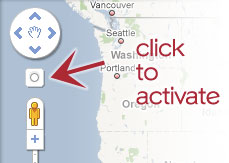Google Expands ‘My Location’ On The Desktop, Tests Search Layers In Maps
Two pretty cool things coming out of Google Maps today: First, an official announcement that Google’s “My Location” feature is now available more widely on the desktop. Second, Google Operating System has discovered what looks like a test that lets users create “search layers” in Google Maps. More on that in a moment. If you’ve […]
Two pretty cool things coming out of Google Maps today: First, an official announcement that Google’s “My Location” feature is now available more widely on the desktop. Second, Google Operating System has discovered what looks like a test that lets users create “search layers” in Google Maps. More on that in a moment.
If you’ve used Google’s mobile Maps application, you know (and probably enjoy) the “My Location” feature that pinpoints where you are and makes searching nearby much more convenient. A couple months ago, Google announced that My Location was available on the desktop via a new version of the Google Toolbar. It’s now available on a wider basis, but is still only supported on certain web browsers: FireFox 3.5, Google Chrome 2.0 and higher, and any browser with the latest version of Google Gears installed. (Note: I’m running an older version of Firefox with Gears installed, but the feature is not available to me. It’s not available on my older G5 Power Mac, but is available on my newer Intel-based Macbook; same browser on both.)

The second addition I mentioned above is a test feature in Google Maps that saves your recent searches and lets you add those earlier results as layers on top of your most recent search. On the screenshot below, searches for Italian and Chinese restaurants in Seattle are shown together, and each set of results is color-coded.
You can combine any combination of searches — like “seattle hotels” and “seattle italian restaurants” or “seattle movie theaters” and “seattle hotels.” The possibilities are wide open for this very cool and potentially very helpful feature.
Postscript, July 22: Google has announced that this feature is now live for all users.
Opinions expressed in this article are those of the guest author and not necessarily Search Engine Land. Staff authors are listed here.
Related stories
